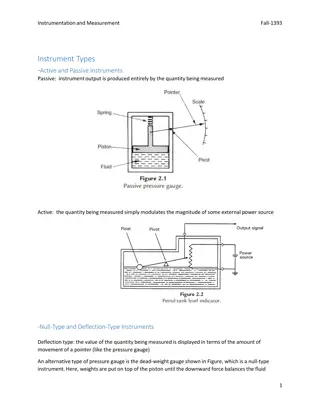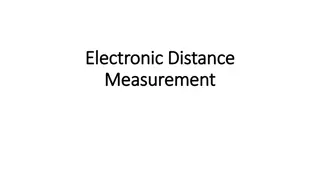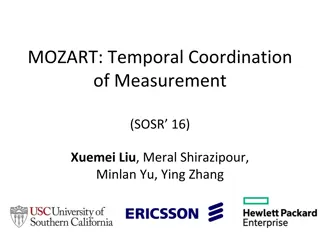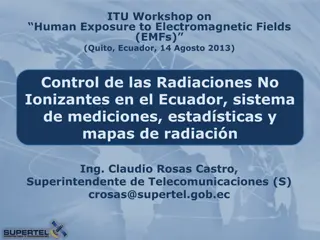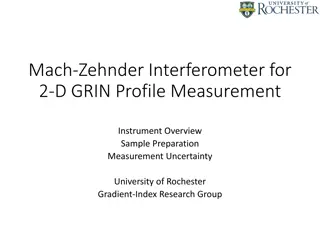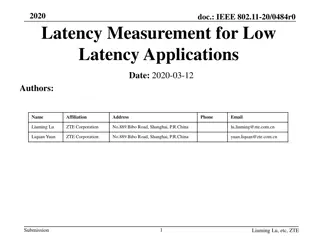Conductometry: An Overview of Measurement and Applications
Conductometry involves measuring the conductivity of a solution to determine its properties. This method includes factors affecting conductivity, conductometric titration, recent developments, and application examples. The process involves using electrodes, primary standard solutions, Wheatstone bridge, and considering factors like ion size, temperature, and molar conductance. The goal is to determine the specific conductance of an electrolytic solution accurately.
Download Presentation

Please find below an Image/Link to download the presentation.
The content on the website is provided AS IS for your information and personal use only. It may not be sold, licensed, or shared on other websites without obtaining consent from the author. Download presentation by click this link. If you encounter any issues during the download, it is possible that the publisher has removed the file from their server.
E N D
Presentation Transcript
CONDUCTOMETRY Dr. B.C.Roy Engineering College Dr. Saurav Ranjan Das Department of Chemistry 1
Contents: 1.Conductometry-: Introduction Ohm s law. Conductometric measurements. Factor affecting conductivity. Application of conductometry. 2.Conductometric titration-: Introduction. Types of conductometric tiration. Advantages of conductometric tiration. 3.Recent devlopement 4.References . 2
Total conductance of the solution is directly proportional to the sum of the n individual ion contributions . G = ci m,i 4
Conductivity measurements 1. Electrodes Two parallel platinized Pt. foil electrodes or Pt. black with electrodeposited a porous Pt. film which increases the surface area of the electrodes and further reduces faradaic polarization. 2. Primary standard solutions Primary standard KCl solution ,at 25 , 7.419g of KCl in 1000g o f solution has a specific conductivity of 0.0128 6 -1/cm. 6
3. Conductivity Cell : Avoid the change of temperature during determination 4.Wheat stone bridge : 7
Factors affecting conductivity: Size of ions Temperature Number of ions Charge of ions Specific conductivity:-It is conductivity offered by a substance of 1cm length and 1sq.cm surface area. units are mhos/cm. Equivalent conductivity:-it is conductivity offered by a solution containing equivalent weight of solute in it. 8
Molar conductance of various ions at infinite dilution at 25 molar conductance ions 73.52 K+ 50.11 Na+ Li+ 38.69 H+ 349.82 Ag+ 61.92 Cl- 76.34 78.4 Br- 198 OH- 9
The determination of specific conductance of an electrolytic solution, thus, consists of two steps: Determination of cell constant by using a standard KCl solution of known concentration in the conductivity cell. Determination of resistance of he given solution using the same cell. The reciprocal conductance. Multiplication of conductance and cell constant gives the value of specific conductance of the solution. of this gives the value of In conductance measurements, the solutions are always prepared in conductivity water which has no conductance due to dissolved impurities. It is prepared by distilling a number of times the distilled water to which a little KMnO4and KOH have been added in a hard glass distillation assembly. Such water has very low conductance of the order of 4.3 10- 8ohm-1. For ordinary purposes, double distilled water may be used. 11
APPLICATIONS OF CONDUCTOMETRY It can be used for the determination of:- Solubility of sparingly soluble salts I onic product of water Basicity of organic acids Salinity of sea water (oceanographic work) Chemical equilibrium in ionic reactions Conductometric titration 12
CONDUCTOMETRIC TITRATIONS: The determination of end point of a titration by means of conductivity measurements are known as conductometric titrations. 13
Types of conductometric titrations: Acid-base titration Precipitation titration Replacement titration Redox (oxidation-reduction) titration Complexometric titration 14
Strong Acid with a Strong Base. e.g. HCl with NaOH: Before NaOH is added, the conductance is high due to the presence of highly mobile hydrogen ions. When the base is added, the conductance falls due to the replacement of hydrogen ions by the added cations as H+ ions react with OH ions to form undissociated water. This decrease in the conductance continues till the equivalence point. At the equivalence point, the solution contains only NaCl. After the equivalence point, the conductance increases due to the large conductivity of OH- ions 15
Weak Acid with a Strong Base, e.g. acetic acid with NaOH: Initially the conductance is low due to the feeble ionization of acetic acid. base, there is decrease in conductance not only due to the replacement of H+ by Na+ but also suppresses the dissociation of acetic acid due to common ion acetate. On the addition of But very soon, the conductance increases on adding NaOH as NaOH neutralizes the un- dissociated CH3COOH to CH3COONa which is the strong electrolyte. This increase in conductance continues raise up to the equivalence point. The graph near the equivalence point is curved due the hydrolysis of salt CH3COONa. Beyond the equivalence point, conductance increases more rapidly with the addition of NaOH due to the highly conducting OH ions 16
Weak Acid with a Weak Base: The nature of curve before the equivalence point is similar to the curve obtained by titrating weak acid against strong base. After the equivalence point, conductance virtually remains same as the weak base which is being added is feebly ionized and, therefore, is not much conducting 17
Mixture of a Strong Acid and a Weak Acid vs. a Strong Base or a Weak Base: In this curve there are two break points. The first break point corresponds to the neutralization of strong acid. When the strong acid has been completely neutralized only then the weak acid starts neutralizing. The second break point corresponds to the neutralization of weak acid and after that the conductance increases due to the excess of OH ions in case of a strong base as the titrant. However, when the titrant is a weak base, it remains almost constant after the end point similar to previous titration 18
PRECIPITATION TITRATIONS:- [K +Cl]+[Ag +No ] A reaction may be made the basis of a conductometric precipitation titration provided the reaction product is sparingly soluble or is a stable complex. The solubility of the precipitate (or the dissociation of the complex) should be less than 5%. The addition of ethanol is sometimes recommended to reduce the solubility in the precipitations. + - + _ 3 19
REPLACEMENT TITRATIONS Salt of strong acid and weak base vs. strong base Ex: ammonium chloride vs. sodium hydroxide Salt of strong base and weak acid vs. strong acid Eg: sodium acetate vs. hydrochloric acid 20
COMPLEXOMETRIC TITRATION Ex.:-KCl vs. Hg(ClO4)2 Non-aqueous titrations can also be measured using conductometry. Ex:- a)titration of weak bases vs. perchloric acid in dioxan-formic acid. b)Titration of weak organic acids in methanol vs. tetra methyl ammonium hydroxide in methanol- benzene. 21
ADVANTAGES OF CONDUCTOMETRIC TITRATIONS No need of indicator Colored or dilute solutions or turbid suspensions can be used for titrations. Temperature is maintained constant throughout the titration. End point can be determined accurately and errors are minimized as the end point is being determined graphically. 22
RECENT DEVLOPEMNTS In refinary industries. Estimation of polyelectrolytic solution. Biotechnology. Microbiosensors for enviromental monitoring. 23
THANK YOU 24



